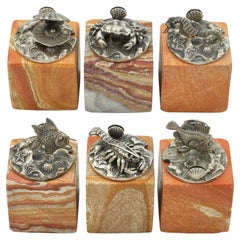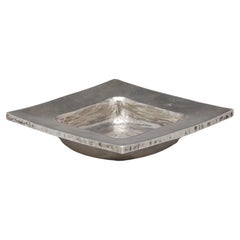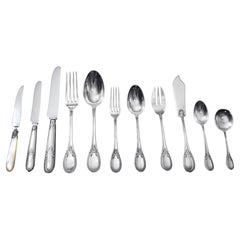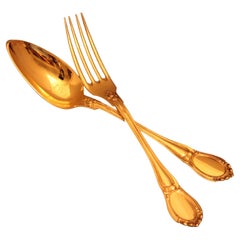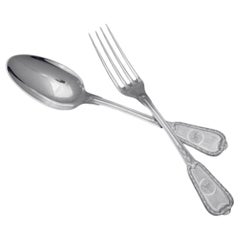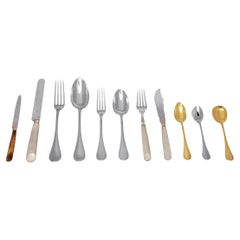Paris - Sterling Silver
to
15
77
1
39
37
14
18
2
3
1
1
1
2
1
23
11
6
6
4
2
1
77
77
63
11
10
5,548
4,025
70
49
8
6
4
77
77
77
8
5
5
5
3
Item Ships From: Paris
Buccellati six card-holders sterling silver Ocean-themed
By Buccellati
Located in Paris, FR
This rare set of six place card holders (place card) by M. Buccellati is a tribute to the marine world, captured through the elegance of Italian silversmithing. Each piece is finely ...
Category
20th Century Italian Paris - Sterling Silver
Materials
Silver, Sterling Silver
Ashtray by Rey Urban in Sterling Silver Sweden 1970 Signed and Stamped
By Rey Urban
Located in Paris, FR
Ashtray by Rey Urban in sterling silver Sweden 1970 signed and stamped
Good condition
Weight: 260 gr.
Category
Mid-20th Century Finnish Scandinavian Modern Paris - Sterling Silver
Materials
Sterling Silver
Henin - 138pc. Antique Louis XVI French 950 Sterling Silver Flatware Set
By Henin et Cie 1
Located in Wilmington, DE
Direct from a Private Chateau in France, A Stunning 138pc. Privately Commissioned Louis XVI Sterling Silver Flatware Set (Service for 12) with 6 Serving Pieces by Internationally Kno...
Category
Late 19th Century French Louis XVI Antique Paris - Sterling Silver
Materials
Sterling Silver
$18,112 Sale Price / set
24% Off
Hippolyte Thomas - 36pc French Vermeil 19th Century Dessert Flatware Set !
By French House & Garden
Located in Wilmington, DE
Direct from Paris, a magnificent 36pc antique French 19th century gold plated sterling silver (vermeil) dessert flatware set by internationally renowned French silversmith “Hippolyte...
Category
Mid-19th Century French Louis XVI Antique Paris - Sterling Silver
Materials
Vermeil, Sterling Silver
Christofle (Cardeilhac) - 44pc 950 Sterling Silver Flatware Set, Bagatelle Model
By Cardeilhac
Located in Wilmington, DE
Direct from Paris, A Magnificent 44pc. 950 Sterling Silver Louis XVI Flatware "Starter Set" by France's Premier Silversmiths Jacques and Pierre Ca...
Category
Early 20th Century French Art Nouveau Paris - Sterling Silver
Materials
Sterling Silver
Aucoc - 166pc. Antique French 950 Sterling Silver & Vermeil Flatware Set + Chest
By A. Aucoc
Located in Wilmington, DE
Direct from Paris, A Magnificent 166pc. 950 Sterling Silver and Vermeil Flatware Set by Andre Aucoc "Silversmith to the Kings and Queens of Europe...
Category
1890s French Louis XVI Antique Paris - Sterling Silver
Materials
Vermeil, Sterling Silver
Queille & Soufflot - 37pc. Antique French 19th Century Dessert Flatware Set !
By Henri Soufflot 1, Pierre François Queille 1
Located in Wilmington, DE
Direct from Paris, a stunning 37pc. 19th century, dessert flatware set by two of France’s premier silversmiths “Pierre Queille” and “Henri Soufflot” in excellent condition and includ...
Category
Late 19th Century French Louis XV Antique Paris - Sterling Silver
Materials
Sterling Silver
David Deakin Silver and Malachite Box for Deakin & Francis England 1970 Signed
By Deakin & Francis
Located in Paris, FR
David Deakin, a silver box, Deakin & Frances, Birmingham, England, 1973, signed.
Gilded inside. Height 10 cm. Total weight: 343 grams.
Unique piece made o...
Category
Mid-20th Century English Mid-Century Modern Paris - Sterling Silver
Materials
Malachite, Silver, Sterling Silver
Pekka Turtiainen Silver Tray Helsinki 1970. Signed
Located in Paris, FR
Hand made Pekka Turtiainen Sterling Silver tray made with Samodorok technique in Helsinki by A. Sirtano circa 1970. Signed by the designer and stampe...
Category
Mid-20th Century Finnish Mid-Century Modern Paris - Sterling Silver
Materials
Silver
Rare Crystal Square Shape Delicate Pair Silver Ewers Mounted by Boivin C.1900
By Victor Boivin
Located in Paris, FR
Pair of very refined ewers in engraved crystal beautifully mounted, part of the silver sterling base is like lace! a work that few silversmiths could do.
The octagonal base is decora...
Category
Early 1900s French Aesthetic Movement Antique Paris - Sterling Silver
Materials
Crystal, Silver
$8,786 Sale Price / set
30% Off
Pekka Turtiainen Silver Samodorok a Sugar Bowl 1 Cream Jug Sweden 1970 Stamped
Located in Paris, FR
Pekka Turtiainen, A sugar bowl and a cream jug with outer surface in Solid silver samodorok technique, Helsinki 1972. Stamped
Gilt interiors. Width o...
Category
Mid-20th Century Finnish Mid-Century Modern Paris - Sterling Silver
Materials
Silver
Silver Salt and pepper by Hans Hansen Denmark 1967 dated and Signed
By Hans Hansen
Located in Paris, FR
Very rare Silver Salt and Pepper by Hans Hansenmade in Denmark in 1967
Signed on the bottom of each piece.
Good condition
Category
Mid-20th Century Danish Mid-Century Modern Paris - Sterling Silver
Materials
Silver, Sterling Silver
Silver Georg Jansen Moka Spoon Model "Pyramid" Set of 6 Denmark, 1960
Located in Paris, FR
Georg Jensen (Denmark. 1866-1935)
a set of six silver mocca spoons model Pyramid designed by Harald Nielsen for Georg Jensen. Weight ca 66 gram
In its original box. Length ca 9.5 c...
Category
Mid-20th Century Danish Paris - Sterling Silver
Materials
Sterling Silver
Sterling silver vase by Tapio Wirkkala for Kultakeskus
By Kultakeskus Oy, Tapio Wirkkala
Located in PARIS, FR
This sterling silver vase, designed in 1954 by Tapio Wirkkala and executed by Kultakeskus Oy in 1959, stands out for its sleek and refined design. The vase features an oval shape wit...
Category
1950s Finnish Mid-Century Modern Vintage Paris - Sterling Silver
Materials
Sterling Silver
Tetard Freres - 115pc. French Sterling Silver Flatware Set + Storage Chest
By Tetard Freres
Located in Wilmington, DE
Direct from Paris, a Magnificent 115pc. French Sterling Silver Flatware Set + Storage Chest by one of France’s Premier Silversmiths “Tetard Freres” in Near New Condition. Tetard Frè...
Category
Late 20th Century French Louis XV Paris - Sterling Silver
Materials
Sterling Silver
Tetard Freres - 112pc. Antique French Sterling Silver Flatware Set, Uniplat !
By Tetard Freres
Located in Wilmington, DE
Direct from Paris, a stunning 112pc. antique French sterling silver flatware set by one of France’s premier silversmiths “Tetar...
Category
Late 19th Century French Antique Paris - Sterling Silver
Materials
Sterling Silver
Berthier - 11 Original Art Nouveau 950 Sterling Silver Flatware Serving Pieces
By Philippe Berthier
Located in Wilmington, DE
Direct from Paris, a Magnificent Set of 11 "Original Art Nouveau" Flatware Serving Pieces in French 950 Sterling Silver by Internationally Known French Silversmith "Philippe Berthier...
Category
Late 19th Century French Art Nouveau Antique Paris - Sterling Silver
Materials
Sterling Silver
Recently Viewed
View AllMore Ways To Browse
International Sterling Spring Glory
Joseph Willmore
Joseph Motto
Onslow Sterling Silver
Powder Jars
Royal Copenhagen 1906
Royal Crest Silver Flatware
Keller Paris Silver
Mexican Silver Overlay
Monogram Napkin Ring Sterling Silver
Mother Of Pearl Flatware Antique
Mother Of Pearl Silverware
Passover Silver
Reed And Barton Antique Sterling Patterns
Reed And Barton Antique Sterling Silver Patterns
Reed And Barton Dish
Royal Copenhagen Collector Plates
Royal Danish International Sterling
